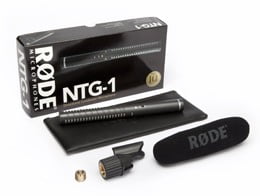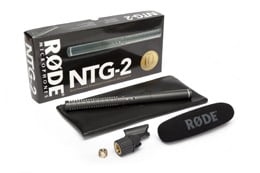Are you shooting a film? Interviewing players at sports events? Doing news broadcasts?A good shotgun mic will focus in on the sounds you want and ignore ambient noise. Let’s examine these three by RODE to see which one is best for you.
Rode NTG1 Condenser Shotgun Microphone

The NTG1 rejects rear and axis sound with its tight pattern so it focuses in on just the sounds in front. Its own self-noise is just 18dB so there’s no hum noticeable. When used with the included foam wind screen (or better yet, a furry wind shield, sold separately) and the high-pass filter to reduce traffic rumble, it works well for interviews on the street. Since it weighs only 3.7 ounces, it’s definitely light enough to serve as a boom mic. It can also withstand a sound pressure level (SPL) of 139dB.
The frequency response range is 20Hz to 20kHz and the output impedance is a low 50 ohms. The mic itself is a condenser transducer with a half-inch capsule. Note that the high-pass filter is difficult to switch on and off without using a pen or some other slender object.
Unlike the NTG2, this microphone only runs off phantom power through an XLR connector so it doesn’t connect to all cameras. It needs 48 volts provided by the camera, a mixer, or another external source.
More features of the RODE NTG1 microphone
- 1-year limited warranty extends to 10 years with registration
- Rugged metal housing: machined aluminum with epoxy finish
- About 11 inches long and almost an inch in diameter
- High-pass filter is two-step: flat or 80Hz
- Directional pattern is super-cardioid
- Comes with stand mount (for 3/8” or 5/8” thread), foam wind screen for light breezes, and zip pouch for storage
Rode NTG2 Condenser Shotgun Microphone

Want to operate a microphone off of a battery? Many DSLR cameras don’t have a way to power an external mic like this. RODE provides the solution: the NTG2 runs off an AA or off 48V phantom power. The AA battery fits into a compartment inside the mic’s metal housing.The bottom part of the mic below the high-pass filter unscrews but doesn’t come all the way off so the battery can slip inside. With the battery, this mic is about twos ounces heavier than the NTG1.
Another difference between the NTG1 and NTG2 is the lower maximum SPL (sound pressure level) of 131dB. The NTG2 also has higher output impedances, depending on if it has battery or phantom power. Its own self-noise is the same as the NTG1.The NTG2 also has a switchable high-pass filter that is difficult to turn on and off without using a pen or screwdriver. But both of these mics work well for street interviews, weddings and other events, and even film-making.
The two mics look similar in their black matte metal aluminum housing and have the same accessories included in the box. The NTG2 is made for the same kind of sound recordings as the NTG1, it just has the additional flexibility of battery power.
More features of the RODE NTG2 microphone
- 1-year limited warranty extends to 10 years with registration
- Weighs 5.17 ounces and is about 11 inches long with 0.87-inch diameter
- Comes with stand mount for 3/8” and 5/8” threads, foam wind screen for light breezes, and zip pouch for storage
- Output impedance with battery is 350 ohms; 250 ohms with phantom power (be sure to connect to an input with the same or higher impedance to avoid signal loss)
- High-pass filter is two-step: flat or 80Hz
- Directional pickup pattern is super-cardioid
Rode NTG3 Condenser Shotgun Microphone with Storage Cylinder

The NTG3 is a step-up in durability from the two previous microphones. With external RF bias anda true condenser, this mic is made to withstand moisture, bad weather conditions, and even external radio frequency interference. The housing is solid machined brass and comes in three colors, including an anti-glare version. The mic comes with a weatherproof aluminum storage cylinder, too.
The output impedance on this mic is the lowest of the three at just 25 ohms. Its self-noise (or equivalent noise) is also the lowest at just 13dB. When RODE says that this mic has very little handling noise, they mean it. It really cuts down on the rustle, rumble, and buzz that some mics suffer from. Many users have commented that this has the richest and truest sound of any mic they own. RODE claims it has the lowest noise of any similar microphone.
Unfortunately, it runs only on 48V phantom power through an XLR connector, and not on batteries (unless they are an external 48-volt power source). There is no high-pass or low-cut filter on this mic like there is on the other two.It’s the heaviest of the three mics at 5.75 ounces, but its size is about the same. It’s still a great mic for booms.
Like the other two mics, it has a super-cardioid pickup pattern so it records what’s in front and not what’s on the sides or rear. It’s made for high-resolution audio recording, and does well picking up even individual instruments playing in an orchestra. The maximum SPL is 130dB, so it’s better for films and interviews rather than rock concerts.
More features of the RODE NTG3 microphone
- 1-year limited warranty extends to 10 years with registration
- Comes with aluminum transport tube, foam wind (pop) filter, mic clip, and zip pouch
- Frequency range is 40Hz to 20kHz, slightly less than the other two mics
- Pickup pattern is super-cardioid
Recommendation
If you want a great directional mic, something that works equally well for studio work, man-on-the-street interviews, and film-making, all three of these models are ideal.
The main difference between the NTG1 and the NTG2 is the power source they need and their output impedances.The NTG1 has a low output impedance of only 50 ohms so it can tolerate longer cables. It only operates on 48-volt phantom power.
The NTG2 has a higher output impedance of 250-350 ohms and will need a matching or higher impedance on a mixer or other input. But it can run on an AA battery, which is a boon to those who don’t yet have a 48-volt phantom power setup.
If you’re working in adverse weather conditions, especially humid environments, consider getting the water-resistant (but not waterproof) NTG3. It even comes with a weather-proof storage case. Although it comes with a foam filter against wind noise and plosives, think about getting a furry wind muff too. In the studio, the NTG3 shines because of its super low handling noise. Out of the three mics in this review it gets the most praise for true and rich sound.
Click here to purchase Rode NTG1 on Amazon!
Click here to purchase Rode NTG2 on Amazon!
Click here to purchase Rode NTG3 on Amazon!